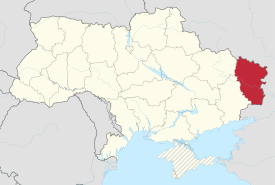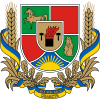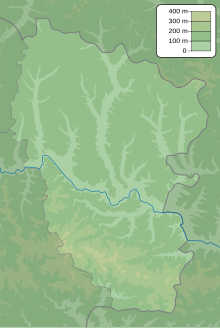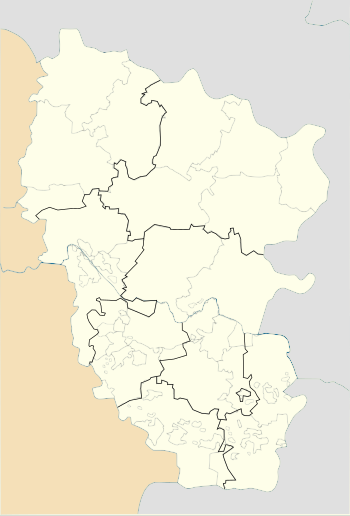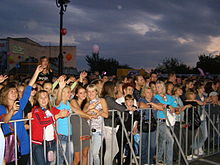
Donetsk Oblast, also referred to as Donechchyna, is an oblast in eastern Ukraine. It is Ukraine's most populous province, with around 4.1 million residents. Its administrative centre is Donetsk, though due to the ongoing Russo-Ukrainian War, the regional administration was moved to Kramatorsk. Historically, the region has been an important part of the Donbas region. From its creation in 1938 until November 1961, it bore the name Stalino Oblast, in honour of Joseph Stalin. As part of the de-Stalinization process, it was renamed after the Siversky Donets river, the main artery of Eastern Ukraine. Its population is estimated at 4,100,280.

The Donbas or Donbass is a historical, cultural, and economic region in eastern Ukraine. Parts of the Donbas are occupied by Russia as a result of the Russo-Ukrainian War.
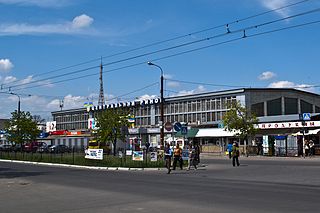
Sievierodonetsk, also spelled Severodonetsk, is a city in Luhansk Oblast, eastern Ukraine. It is located to the northeast of the left bank of the Donets river and approximately 110 km (68 mi) to the northwest from the administrative center of the oblast, Luhansk. Sievierodonetsk faces neighbouring Lysychansk across the river. The city, whose name comes from the above-mentioned river, had a population of 99,067, making it then the second-most populous city in the oblast. Since June 2022, it has been militarily occupied and administered by Russia.

Lysychansk, is a city in Sievierodonetsk Raion, Luhansk Oblast, eastern Ukraine. It is located on the high right bank of the Donets River, approximately 115 kilometres (71 mi) from the administrative center of the oblast, Luhansk. It faces Sievierodonetsk across the river. Its population before the Russian invasion of Ukraine was approximately 93,340.

Rubizhne is a city in Luhansk Oblast, in the Donbas region of eastern Ukraine. Situated on the left bank of the Donets River near the cities of Sievierodonetsk and Lysychansk. Prior to 2020, it was a city of oblast significance, before the designation was abolished.

Popasna is a city in Sievierodonetsk Raion, Luhansk Oblast, Ukraine. It is the administrative center of Popasna urban hromada, one of the hromadas of Ukraine. In 2018, it was estimated that it had a population of 20,600 people.

Svatove is a city on the Krasna River in Luhansk Oblast, eastern Ukraine. It serves as the administrative center of Svatove Raion. Its population is 16,145. It has been occupied by Russia since 2022.

Lutuhyne is a city in the Luhansk Raion of Luhansk Oblast (region) of Eastern Ukraine, Donbas. The 2022 population was 17,061.
Zolote is a city in Sievierodonetsk Raion, Luhansk Oblast, eastern Ukraine. Population: 13,007. The town consists of villages that were merged to create Zolote. Currently these villages are numbered in a sequence from Zolote 1 to Zolote 5. Before the creation of Zolote they were named Karbonit, Rodina, Stakhanovets, Maryvka and Partyzansky.

Hirske is a city in Sievierodonetsk Raion, Luhansk Oblast, eastern Ukraine. It is the administrative center of Hirske urban hromada, one of the hromadas of Ukraine. Its population is 9,100.

Krasnodon Raion or Sorokyne Raion was a raion (district) in Luhansk Oblast, Ukraine from 1923 to 2020. The administrative center of the raion was Krasnodon, also known as Sorokyne. The last estimate of the raion population before its abolition was 28,943.

Popasna Raion was a raion (district) in Luhansk Oblast, Ukraine until its abolition in 2020. The administrative center was the town of Popasna. The last estimate of the raion population was 74,028.

The Luhansk People's Republic or Lugansk People's Republic is an internationally unrecognised republic of Russia in the occupied parts of eastern Ukraine's Luhansk Oblast, with its capital in Luhansk. The LPR was proclaimed by Russian-backed paramilitaries in 2014, and it initially operated as a breakaway state until it was annexed by Russia in 2022.
Luhansk Oblast is subdivided into districts (raions) which are subdivided into territorial communities (hromadas).
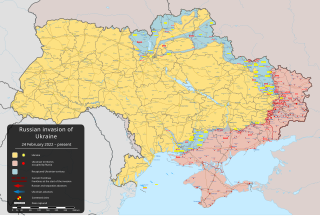
The Russian-occupied territories of Ukraine are areas of Ukraine that are currently controlled by Russia in the course of the Russo-Ukrainian War. In Ukrainian law, they are defined as the "temporarily occupied territories of Ukraine".
Novoaidar is an urban-type settlement in Luhansk Oblast, in the Donbas region of eastern Ukraine. Novoaidar is 57km, by road from regional centre Luhansk, 43km from Sieverodonetsk, and 747km from Kyiv. Novoaidar is located on the river Aidar, and is on Highway H21, which runs from Donetsk to Starobilsk.
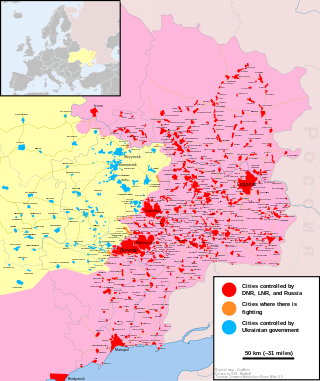
The battle of Donbas was a military offensive that was part of the wider eastern Ukraine campaign of the Russian invasion of Ukraine. The offensive began on 18 April 2022 between the armed forces of Russia and Ukraine for control of the Donbas region. Military analysts consider the campaign to have been the second strategic phase of the invasion, after Russia's initial three-pronged attack into Ukraine.

Bilohorivka is an urban-type settlement in Sievierodonetsk Raion, Luhansk Oblast, eastern Ukraine. It is located in Lysychansk urban hromada, one of the hromadas of Ukraine. It is located approximately 88 kilometres (55 mi) northwest from the centre of Luhansk and 25 kilometres (16 mi) west-south-west from Sievierodonetsk. The population is 808.

The battle of Toshkivka was an armed conflict around the city of Toshkivka, a mountainous municipality in the Sievierodonetsk Raion of Luhansk Oblast, as part of the Russian invasion of Ukraine in 2022.
Khriashchuvate is a rural-type settlement in the Donbas region of eastern Ukraine. It is located directly south-east of Luhansk, Novosvitlovka, in the Krasnodon Raion, 39 kilometres (24 mi) from Krasnodon. Khriashchuvate has been under the control of the Lugansk People's Republic from autumn 2014, in the war in Donbas. Following their 2022 annexation referendum, Russia claimed the entire Luhansk Oblast, including Khriashchuvate, as part of their LPR / LNR. As of 2022, the population of Khriashchuvate was 1216.
